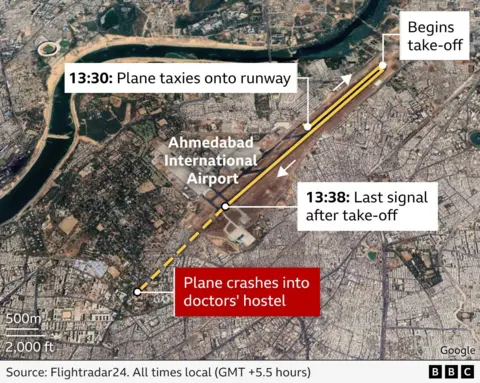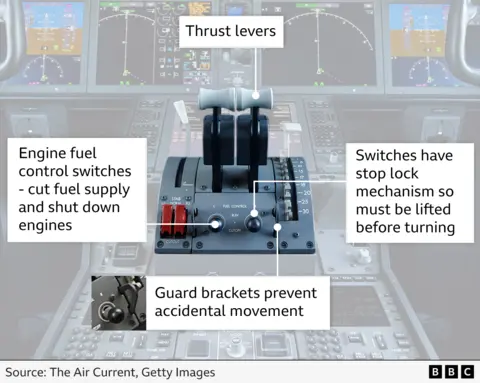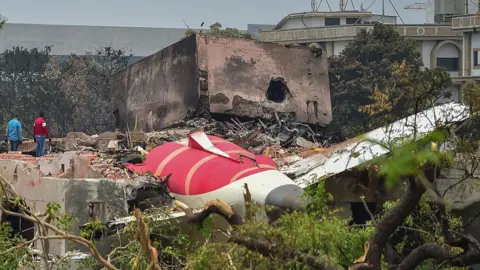Investigators have made a chilling discovery in the preliminary investigation into the Air India Flight 171 crash which killed 260 people in June.
Just seconds after take-off, both of the 12-year-old Boeing 787 Dreamliner’s fuel-control switches abruptly moved to the “cut-off” position, starving the engines of fuel and triggering total power loss. Switching to “cut-off” is a move typically done only after landing.
The cockpit voice recording captures one pilot asking the other why he “did the cut-off”, to which the person replies that he didn’t. The recording doesn’t clarify who said what. At the time of take-off, the co-pilot was flying the aircraft while the captain was monitoring.
The switches were returned to their normal inflight position, triggering automatic engine relight. At the time of the crash, one engine was regaining thrust while the other had relit but had not yet recovered power.
Air India Flight 171 was airborne for less than 40 seconds before crashing into a crowded neighbourhood in the western Indian city of Ahmedabad, marking one of India’s most baffling aviation disasters.
Investigators are probing the wreckage and cockpit recorders to understand what went wrong just after take-off. The Air India flight climbed to 625 feet in clear weather before losing location data 50 seconds in, per Flightradar24. Saturday’s 15-page report offers early insights.
The investigation – led by Indian authorities with experts from Boeing, General Electric, Air India, Indian regulators, and participants from the US and UK – raises several questions.
Investigators say the lever-lock fuel switches are designed to prevent accidental activation – they must be pulled up to unlock before flipping, a safety feature dating back to the 1950s. Built to exacting standards, they’re highly reliable. Protective guard brackets further shield them from accidental bumps.
“It would be almost impossible to pull both switches with a single movement of one hand, and this makes accidental deployment unlikely,” a Canada-based air accidents investigator, who wanted to remain unnamed, told the BBC.
That’s what makes the Air India case stand out.

If one of the pilots was responsible for shutting down the switches, intentionally or not, it “does beg the question: why… pull the switches to the off position,” Shawn Pruchnicki, a former airline accident investigator and aviation expert at Ohio State University, said.
“Was it intentional, or the result of confusion? That seems unlikely, as the pilots reported nothing unusual. In many cockpit emergencies, pilots may press the wrong buttons or make incorrect selections – but there was no indication of such a situation here, nor any discussion suggesting that the fuel switches were selected by mistake. This kind of error doesn’t typically happen without some evident issue,” he told the BBC.

Peter Goelz, a former managing director of the US’s NTSB, echoed a similar sentiment: “The finding is very disturbing – that a pilot has shut off the fuel switch within seconds of flying.”
“There’s likely much more on the cockpit voice recorder than what’s been shared. A lone remark like ‘why did you cut off the switches’ isn’t enough,” he said.
“The new details suggest someone in the cockpit shut those valves. The question is, who, and why? Both switches were turned off and then restarted within seconds. The voice recorder will reveal more: was the flying pilot trying to restart the engines, or the monitoring one?”
Investigators believe the cockpit voice recorder – with audio from pilot mics, radio calls and ambient cockpit sounds – holds the key to this puzzle.
“They haven’t identified the voices yet, which is crucial. Typically, when the voice recorder is reviewed, people familiar with the pilots are present to help match voices. As of now, we still don’t know which pilot turned the switches off and back on,” said Mr Goelz.
In short, investigators say what’s needed is clear voice identification, a full cockpit transcript with labelled speakers, and a thorough review of all communications from the moment the plane was pushed back from the gate to the time it crashed.
They also say this underscores the need for cockpit video recorders, as recommended by the NTSB. An over-the-shoulder view would show whose hand was on the cut-off switch.
Before boarding Flight 171, both pilots and crew had passed breathalyser tests and had been cleared fit to fly, the report says. The pilots, based in Mumbai, had arrived in Ahmedabad the day before the flight and had adequate rest.
But investigators are also zeroing in on what they describe is an interesting point in the report.
It says in December 2018, the US Federal Aviation Administration issued a Special Airworthiness Information Bulletin (SAIB) highlighting that some Boeing 737 fuel control switches were installed with the locking feature disengaged.
While the issue was noted, it wasn’t deemed an unsafe condition requiring an Airworthiness Directive (AD) – a legally enforceable regulation to correct unsafe conditions in a product.
The same switch design is used in Boeing 787-8 aircraft, including Air India’s VT-ANB which crashed. As the SAIB was advisory, Air India did not perform the recommended inspections.
 Getty Images
Getty ImagesMr Pruchnicki said he’s wondering whether there was a problem with the fuel control switches.
“What does this [bit in the report] exactly mean? Does it mean that with a single flip, that switch could shut the engine off and cut the fuel supply? When the locking feature is disengaged, what exactly happens? Could the switch just flip itself to off and shut down the engine? If that’s the case, it’s a really serious issue. If not, that also needs to be explained,” he said.
Others, however, aren’t convinced this is a key issue.
“I haven’t heard of this which appears to be a low-profile FAA issuance. Nor have I heard any complaints [about the fuel switches] from pilots – who are usually quick to speak up. It’s worth examining since it’s mentioned, but it may just be a distraction,” said Mr Goelz.
Capt Kishore Chinta, a former investigator with India’s Aircraft Accident Investigation Bureau (AAIB), wonders whether the switches tripped because of a problem with the plane’s electronic control unit.
“Can the fuel cut-off switches be triggered electronically by the plane’s electronic control unit without movement by the pilot? If the fuel cut-off switches tripped electronically, then it’s a cause for concern,” he told the BBC.
The report says fuel samples from the refuelling tanks were “satisfactory”. Experts had earlier suggested fuel contamination as a possible cause of the dual engine failure. Notably, no advisory has been issued for the Boeing 787 or its GE GEnx-1B engines, with mechanical failure ruled out for now pending further investigation.
It also said that the aircraft’s Ram Air Turbine (RAT) had deployed – a clear sign of a major systems failure – and the landing gear was found in “down position” or not retracted.
The RAT, a small propeller that extends from the underside of the Boeing 787 Dreamliner, acts as an emergency backup generator. It automatically deploys in flight when both engines lose power or if all three hydraulic systems register critically low pressure, supplying limited power to keep essential flight systems operational.
“The deployment of the Ram Air Turbine (RAT) strongly supports the conclusion that both engines had failed,” Mr Pruchnicki said.
A Boeing 787 pilot explained why he thought the landing gear was not retracted.
“These days, every time I take off in a 787, I notice the landing gear retraction process closely. By the time the gear handle is pulled, we’re already at about 200ft (60.9m), and the entire gear retraction process completes by around 400ft – roughly eight seconds in total, thanks to the aircraft’s high-pressure hydraulic system.”
The pilot believes the one flying had no time to think.
“When both engines fail and the aircraft starts going down, the reaction goes beyond just being startled – you go numb. In that moment, landing gear isn’t your focus. Your mind is on one thing: the flight path. Where can I put this aircraft down safely? And in this case, there simply wasn’t enough altitude to work with.”
Investigators say the crew tried to recover, but it happened too fast.
“The engines were switched off and then back on. The pilots realised the engines were losing thrust – likely restarting the left one first, followed by the right,” said Mr Pruchnicki.
“But the right engine didn’t have enough time to spool back up, and the thrust was insufficient. Both were eventually set to “run”, but with the left shut down first and the right too late to recover, it was simply too little, too late.”








